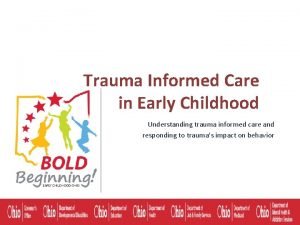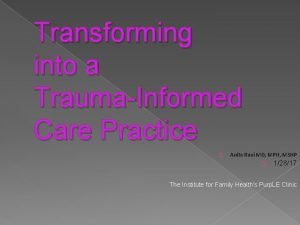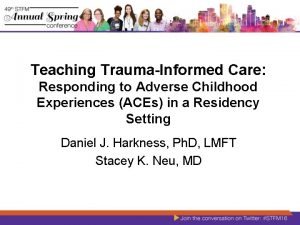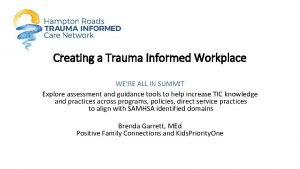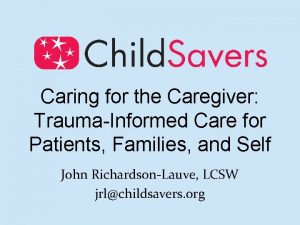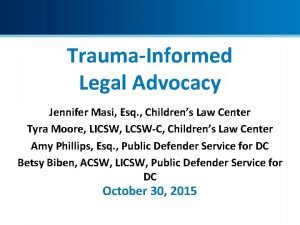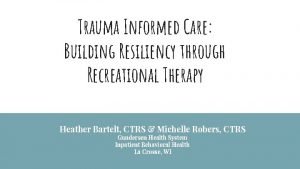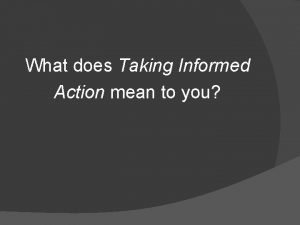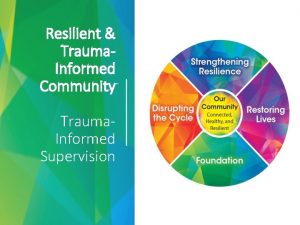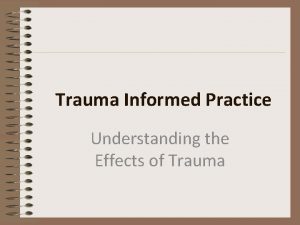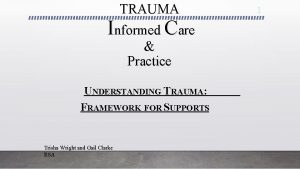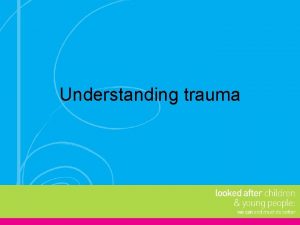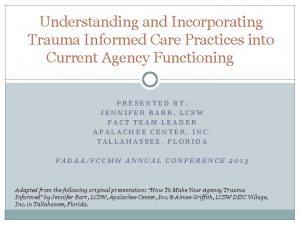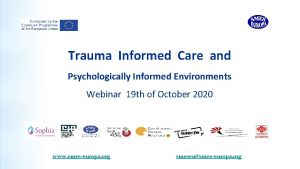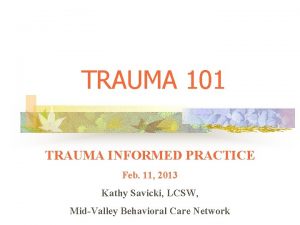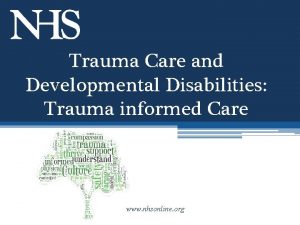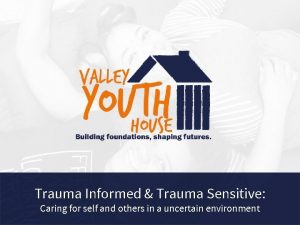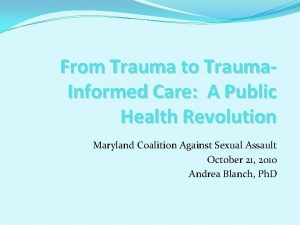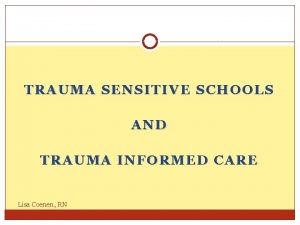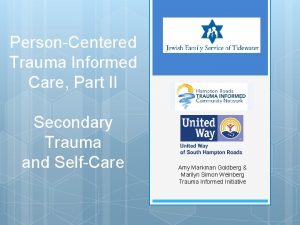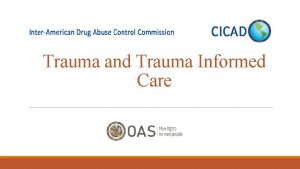Essential Components of Trauma Informed Court Practices Understanding



















































- Slides: 51

Essential Components of Trauma Informed Court Practices: Understanding the Behavioral Adaptations of Sex Workers in a Judicial Setting Pamela Albers, LCSW, BACS New Orleans Family Justice Alliance

Learning Objectives – or why is this important By the end of this training attendees will understand: • Introduction to: o Types of sex work, terminology, who is considered a sex worker, and types of issues sex workers face • Increase awareness of personal values/biases regarding the sex trade and sex workers • How trauma impacts the mental health, physical health and the general ability to navigate daily life for a sex worker • PTSD manifestations in sex workers • Trauma Informed care – a paradigm shift • The issues of power and control in both sex work and the legal response to sex work

Defining Sex Work • Sex work is the commercial exchange of a sexual service for money, other benefits like housing, drugs, transportation or other survival needs. • This term is used to define a broad range of transactions and sex workers are not a homogenous group. • This work is about power and control – see power and control wheel.

Who is considered a sex worker? • Types of workers: escorts, exotic dancers, dominatrices, phone sex operators, sensual massage professional, actors in adult films, etc. • Types of work environments: Indoors, Outdoors, Agency or Independent • The sex trade is large and complex o Many levels o Can work independently or with a manager/ agency • Legality o Varying levels of legality o Different types of workers experience different challenges

Where Does Sex Work Take Place? • Indoor and outdoor (the street) • Street sex work accounts for a varying degree of the trade depending on location • Los Angeles, San Francisco and New York • Smaller cities 12 -15% as much as 50% • The internet – source of employment and community • Street based sex workers – “stroll” and often work in pairs • Others work in agencies (with a pimp) massage parlors, clubs, etc. • Independent workers who use their own websites or dating websites to find clients.

Why do sex work? • • Choice Circumstance Coercion Force • The reason can change and it often does over time

• A Few Statistics According to a study done by the Sex Workers Project at the Urban Justice Center in New York City: • 30% of street-based sex workers told researchers that they had been threatened with violence by police officers • 16% (8 of 51) said that they had been in sexual situations with a police officer • 43% stated that they were open to the idea of asking police for assistance but were worried about how helpful they would be • 80% interviewed experienced either violence or threats in the course of their work. • 46% (24 of 51) of indoor sex workers interviewed had been forced by a client to do something he or she did not want to do. **Please be aware that these are NATIONAL statistics and that the definition of sex work being used to calculate the numbers includes many types of sex work – not just prostitution. * Behind Closed Doors: An Analysis of Indoor Sex Work in New York City 2005

Demographics • • • There are not many analyses of sex work in the United States. What is presented is according to a study done by the Sex Workers Project at the Urban Justice Center in New York City: Behind Closed Doors – 2005 The number of people interviewed was 51 in total. Race/Ethnicity: Forty percent of respondents were foreign born (Asia, Latin America, Caribbean and Europe) 27% Latino 12% Asian 15% Black 44% European Descent 2% Mixed race • • Gender 73% women – non-transgender 15% men 12 Transgender women • •

Age of respondents • 4% <20 years • 45% 20 -29 years • 43% 30 -39 years • 4% 40 -49 years • 4% > 50 years Age of entry into sex work The majority began between 15 and twenty years of age The youngest was 11 years of age Oldest age was 37 years old Length of time engaged in sex work: <1 year to 37 years

Level of education • 40% College graduate • 22% Some college • 19% High school • 16% 9 th-11 th grade • 3% Kindergarten to 8 th grade Venues worked in the sex industry* 48% Bars/clubs 43% Brothel 35% Street 33% Escort Service 33% Strip club * Some of the participants in the survey picked more than one venue.

Means of soliciting clients 25% Internet 16% Bars and clubs 15% Word of Mouth 6% Regulars 5% Brothels 4% Street 3% Escort service 3% Dungeon *some responders used more than means to solicit

Percentage of respondents who made enough money to live on prior to engaging in sex work 2 67% Did not make enough money 33% Did make enough money Percentage of respondents for which sex work is the only form of employment 2 54% Sex work is the only employment 46% Employed in addition to sex work Most sex workers enter the industry at times of extreme financial vulnerability. Usually enter the industry because a friend or acquaintance in the business said that the work pays well.

Number of places respondent has lived in the past year • 2 places 17% • 3 places 8% • 4 places 15% • 5 places 6% • 6 places 2% • 7 places 2% • 8 places 2% • 9 places 2% • 10 places 4% • Twenty places 2% • Forty places 2% • N=51 Percentage of respondents who have lived in subsidized housing or temporary shelter 33% 21% 8% 6% Motel/hotel Shelter SRO Public Housing Section 8

• “when I hit 18, I lived on the street because my parents confronted me about being gay. ” --Paul

Legal and other needs • Respondents to this survey were low income women and men who were part of the working poor and were unable to find work that paid them a living wage that allowed them to maintain a balance between work and family. • Transgender sex workers face additional problems due to discrimination and insensitivity to their gender identity • Immigrant sex workers, especially those without a legal status or did not speak English, faced additional hurdles trying to find mainstream employment

Areas that sex workers identified needing help in navigating: • Health Care (comprehensive) • Counseling • Stable Housing • Peer Support (how to be safe in sex work business) • Legal Assistance of all Kinds • Immigration Assistance • Mentoring in Alternative Employment • Managing Money (comes in fast and goes out fast) • Transferring Existing Skills to a Mainstream Job • Language Classes • Accessing Education

True of False? 1. All sex workers are the same and share the same experiences. 2. Violence is part of the job. 3. Sex workers are all survivors of childhood sexual abuse or sexual violence 4. Not all individuals who engage in sex work identify as sex workers 5. All sex workers abuse substances 6. Consensual sex work and trafficking are the same thing 7. Street-based sex workers want to leave the street.

• False 1. Everybody’s circumstances are unique. It is crucial to recognize that we have many communities that we belong to and that this informs our experiences, the support we get and how criminalized we might be. Some of us refer to ourselves as sex workers, some of us do not. • False This not true. While some sex workers do experience violence, it • • • is not inherent to our work. Laws often inhibit the sex workers ability to work in safe conditions. We often don’t feel comfortable reporting a crime because it draws attention to our work. The stigmatized nature of our work often means that violence against us is not taken seriously. False 3. Sex workers ARE NOT all survivors of childhood sexual abuse or sexual violence. True 4. Not all sex workers who engage in sex work in the sex trade identify as sex workers. False 5. In a national survey found a “prevalence of substance use and addiction ranging from 0% to 84%, depending on the population being studied, with substance addiction relatively common among street prostitutes, but rare among women who work off the street. ” One study showed “that nearly 50% of one population of women who used drugs did so before they became prostitutes. ”

• False 6. Trafficking involves coercive methods and the use of fear. Wages are withheld, I. D. s are taken, involves transporting individuals from their home to another country, state, or region. • Consensual adult sex work involves commercial exchange of sexual services for compensation • Is entered into voluntarily • Can be exited voluntarily – although it can be challenging • False 7. Leaving sex work can be complicated and takes planning, support and assistance.

Common Occupational Issues for Sex Workers • Internalized stigma and shame, isolation and worker burn out. • Anxiety related to real and perceived occupational risks: • • Arrest Violence STIs Being “outed” • Trauma as a result of physical and sexual violence and other crimes ( such as robbery) • Stress related to unpredictable income, navigating boundaries and structuring day to day work and home life • Lack of access to physical and mental health care • Disease • Pregnancy

Some things to keep in mind • Exchanging in sexual behavior for money is NOT necessarily the result of a mental illness, or the cause of mental illness. 2 • Be careful to avoid language the implies judgment, negative assumptions and tokenization • Reflect on how your personal attitudes and knowledge about sex work may impact how you interact with a sex worker. Judgmental, biased, dismissive or demeaning treatment or language. • Sex workers live under the daily threat of arrest, deportation and violence. 3 • Sex workers live with stigma, isolation, and invisibility due to the nature of their work. 3

Our dignity was taken away…and a lot of people don’t realize that. They don’t really understand about how our dignity was taken away from us. How we were taught to be ashamed. Then our selfrespect was gone. Once you lose self respect, how can you respect someone else. -- Anonymous

Let’s talk about trauma • Trauma involves: o An experience that is overwhelming. o Some sort of threat to ourselves or others. Physical or emotional. o An overwhelm of our usual systems of coping – creates sense of vulnerability and loss of control. o People feeling helpless and fearful. Over time affects relationships and ways of thinking of the world.

Trauma is in the eye of the beholder What traumatizes one person may not impact the next person as significantly What

Trauma and Memories • Due to high levels of adrenaline and other stress hormones that are circulating through the body during traumatic events, traumatic memories are encoded differently. • Traumatic events are encoded as vivid sensations and images rather than as a verbal narrative, or logical story. • Language coding centers of the brain are inactivated during trauma as part of the fight, flight or freeze response so that the memory is never encoded into language but rather remains as images and sensations. • The inability to recall important aspects of the trauma is a protective mechanism that the brain unconsciously employs to protect the victim.

Perception of trauma of sex workers • • • The emotional and traumatic harm of sex work is invisible to society If the stereotype of harmful sex work (such as a teenager being trafficked at gunpoint from one state to another) is not observed, and we see instead the “smile” of girls and women – we may perceive sex work as a free choice. Sex work becomes normalized We don’t see trauma, we see consent. The conditions for genuine consent are absent – physical safety, equal power with “customers”, and real alternatives

Trauma as an occupational risk of sex work • • • Individuals who have been victimized by working in the sex industry may experience biologically based reactions such at posttraumatic stress disorder (PTSD), dissociative disorders, stress disorders, and depression. For this presentation we will concentrate on PTSD In short, PTSD is a normal reaction to a situation that puts an individual in direct danger, an individual witnesses or hears about something traumatic, or an individual feels like their life in danger. Reactions can include: anger, loss of interest in life (can include suicide but not necessarily), feeling numb (can look like someone is spaced out), lack of emotion (can be perceived as “who cares”), sleep problems, easily startled, nightmares, lack of impulse control, substance use and abuse. The longer, or more violent, the exposure to the traumatic events the more persistent and severe the symptoms

Rates of PTSD • Studies show that between 17% and 63% of sex workers experience PTSD. • Wide margin - but clearly higher than the 3. 5% prevalence rate for the general American population ages 18 years and older. • For women who meet criteria for PTSD, 91% had a chronic (long term) form of the disorder. 5

What pre-existing risk factors contribute to PTSD in sex workers • Greater number of lifetime traumas that include childhood and adult sexual and physical assault. 5 • Childhood abuse and neglect • Family instability (childhood family) • Substance use or abuse • Depression (co-morbid with PTSD or pre-existing) • 4 times more likely to have experienced an adult sexual assault 5 • Homelessness •

How sex workers are traumatized • • • • Threats of harm and actual harm (verbal and physical) Sexual harassment Financial manipulation (offering to pay more to not use a condom) Being threatened with a weapon Robbery Being forced to work even if they feel they are in danger Being beaten No food Being forced to have an abortion Emotional isolation Sexual violence Trafficking (separated from family, friends, and support system) Abuse by law enforcement. 4 • Money withheld by pimps and boyfriends – unable to pay for rent, food, clothing and health care.

• Quote from a street sex worker when asked about her health: • “I’ve had three broken arms, nose broken twice and I’m partially deaf in one ear. I have a small fragment of bone that floats in my head and it gives me migraines. I’ve had a fractured skull. My legs ain’t worth shit no more. I have been burned, scarred and cut with a knife. I’ve been beat with guns, and two by fours. There isn’t a place on my body that hasn’t been bruised somehow, someway, big and small. ” (Giobbe, 1992, p. 126)

“Everyone has the right to have a future that is not dictated by the past. ” --Karen Saakvitne

Components of Trauma Informed Services • • • The stress of the court room environment may affect the ability of trauma survivors to respond and communicate effectively with court personnel. It is important to recognize that acknowledging and understanding the impact of trauma on court participants may lead to more successful interactions and outcomes. A trauma informed approach acknowledges the prevalence and impact of trauma and attempts to create a sense of safety for all participants. Trauma informed interactions begin with good judicial practice, treating individuals with dignity and respect. Judges and court personnel expect the presence of trauma and take care not to duplicate it. Take an individualized approach to maximize opportunity and positive outcomes

Interactions are more effective if they do not “trigger” and therefore re-traumatize • Triggers are events, people, circumstances, sounds, smells, or other environmental factors that “trigger” a trauma response. They remind someone of a past traumatic experience. 7 • Triggers may include: o o o o o Strip searches Yelling Cuffing and other restraints Inspecting personal items Jingling keys Standing too close Being isolated in a locked room Remarks that are demeaning or degrading Staring and whispering

Trauma survivor’s narrative “What the judge did was pretty incredible. He asked me to come forward. It created a sense of privacy. I didn’t have to shout across a really busy courtroom. He really helped me in that simple act of asking me to come closer. I was able to do what I needed to do, and he was able to hear what he needed to hear. I have been in and out of court for a long time – this is judge changed my life with one simple act. “ 7 --Anonymous

Communication Counts • Every interaction is an opportunity for engagement • For trauma survivors words have a great deal of impact – they can be helpful or devastating • Trauma plays an important role in how the court participant perceives what the judge or court personnel have said. • It helps to repeat what you have stated to check for understanding. There is a way to do this without being condescending. • The court room environment can be intimidating even for individuals who have not been traumatized.

Courtroom experience Reaction of Trauma Survivor Trauma Informed Approach A court officer handcuffs a court participant without warning Anxiety about being restrained, doesn’t know what will happen next Individuals who are agitated and frightened are required to wait long periods of time before seeing the judge Increased agitation and anxiety, acting out A judge conducts a sidebar conversation with an attorney Suspicion and feelings of betrayal A participant enters a plea that does not appear to be consistent with the evidence, his or her own description of the event or his or her own best interests “oh – you’re here again” Memory impairment, confusion about courtroom procedures, inability to process implications of the plea Tell the individual that you intend to handcuff them and inform about what will happen next. Explain what will happen and when (“the court officer will handcuff you now”) To the greatest extent possible prioritize who is appearing before you and when. Those who are the most agitated and fearful will have the hardest time waiting and more likely to act out Tell the participant what is happening and why. “We have to discuss some issues related to your case. We just need a minute on the side. ” Adjourn to allow time for courtroom team to discuss whether and how to accept the plea I’m hopeless. Why should I care if I go to jail or not. They expect me to be here anyway Maybe what we’ve been doing isn’t the best way to support you.

Transformation at every level System Agency You

Requirements for Creating Trauma. Informed Services and Setting • • • Administrative (court) commitment to change Training and education Hiring practices Review of policies and procedures Survivor (court participant) input Cultural competency o o Gay Lesbian Transgender Other minorities

Ensuring Cultural Competency “The capacity to function effectively as an individual and an organization within the context of the cultural beliefs, behaviors, and needs presented by survivors and their communities”

• Ensuring cultural competence includes having the knowledge and skills to work within the client’s culture, understanding how one’s own cultural background and the court influences interactions with court participants. • Understanding takes place within a person’s cultural context and support network, and different cultural groups may have unique resources to assist court participants. • It is often helpful, to ask questions, be open, and try to understand a person’s experience and response through the lens of his/her own cultural context.

If You are Trans and a Sex Worker • You are probably more subject to systemic discrimination and violence EVERYDAY! • You may experience: o o o Job discrimination Unstable, unsafe housing Homelessness Unemployment (or the threat of it if you are “found out”) Barriers to health care, education, legal remedy, and social services Primarily due to Transphobia. 10

For all sex workers, and especially Trans sex workers, sex work is a solution to systemic barriers to employment. Sex work is often the ONLY solution due to social marginalization and other social factors.

Why should I cooperate with YOU? • In the world I live and work in: • I probably don’t have much of a support system. • I am discriminated against everywhere I go; if I am Gay, Lesbian or Trans it is even worse. • I am beaten and often abused, if I am a Trans woman I am 98% more likely to be beaten, if I am Trans woman of color, I am 70% more likely to be killed on the job. • People don’t respect me – I don’t care if you do or not. • People think I’m a slut – so you can join the club of many. • I don’t need your pity, and you don’t have to save me. Those and many more automatic thoughts happen in the minds of trauma survivors. It takes time, but with trauma based services, those thoughts turn into these……. .

How Sex Workers Would Like to be Treated • Don’t minimize me. I am the expert in my own experience. • Please educate yourself about why people have anxiety, scars, scabs and other issues. • Accept that I may have trauma symptoms when you deal with me. Please treat me accordingly. • Inform me of my rights – more than once. • Don’t call me “those people. ” I have a name. • Don’t patronize me or talk down to me. • Please don’t assume you know me because of the work that I do. 9

Some final thoughts • Be careful about over generalizations – avoid blending individuals with stereotypes. • Be conscious of your own values and judgments. Take time to understand the motivation around them. • Be aware of stereotypes. Not all sex workers are street based, marginalized, or drug addicts. • Respect a person’s identity. Asking which pronoun they would prefer to be addressed as is a sign of not only respect but compassion and acceptance for that individual. • Male, female and trans sex workers are sometimes the victims of sexual and physical assault. Acknowledge the violence they have experienced and treat them with sensitivity.

• Do not discredit a sex workers account of what has happened and assume he/she is an unreliable witness. • Do not expect a sex worker to trust you. It takes time for that to happen. • Incarcerating an individual does not “save” them; it takes them away from their friends, family, burdens them with a criminal record, and ultimately reduces their ability to transition out of the industry when they choose to do so. • Make an effort to educate yourself about the realities of sex worker’s lives. 11

• “ I think decriminalization is one step towards removing the stigma of prostitution as a valid career choice. . but that is not going to remove the stigma for a long time. There are many things that will be needed. …Being a stripper, it’s legal…it still has a certain connotation to it. It’s kind of a slutty thing to do. You must be a bit of a slut to do that. And that’s something that they would always think of a sex worker as well… You couldn’t possibly be moral or ethical…if you sell yourself out like that… this stigma is a lot harder to remove than the legality about it. ” --female massage parlor owner, former sex worker Beyond Decriminalization: Sex Work, Human Rights and a New Framework for Law Reform. 2006 Pivot Legal Society. www. pivotlegal. org. Downloaded May 2014.


Citations 1. Avenatti, Cassandra, Understanding Sex Work and Supporting Individual Involved in the Sex Trade. Downloaded May 17, 2014 2. Sex Workers Project at the Urban Justice Center, 2005. Behind Closed Doors, an analysis of indoor sex work in New York City. Downloaded: 3. 4. 5. 6. 7 May 15, 2014. Urban Justice Center , 2006. ICCPR Shadow Report : Domestic Criminal Justice Access to Courts. Downloaded May 14, 2014 Roxburgh, A; Degenhardt, L. ; Copeland, J. . BMC Psychiatry. Posttraumatic stress disorder among female street-based sex worker in the greater Sydney area, Australia. 2006, 6: 24 doi: 10. 1186/1471 -244 x-6 -24. Chudakov, B. , Ilan, K. , Belmaker, R. H. , and Cwikel, J. (2002)The motivation and mental health of sex workers. Journal of Sex and Marital Therapy, 28(4), 305 -315. Giobbe, E. (1992). Juvenile prostitution: Profile of Recruitment in A. W. Burgess (ed. ), Child Trauma: issues and research. New York. Garland Publishing. --Essential Components of Trauma-Informed Judicial Practice SAMHSA www. samhsa. gov. Downloaded : May 2014

• • 8. Piche, Danica, Cristen Gleeson, Katrina Pacey, John Lowman, Mary Childs, Sarah Ciarrocchi, Francois Paradis, Emily Rix, Elaine Ryan, Elin Sigurdson, Maia Tsurumi, Laura Track, Megan Vis-Dunbar, and Lisa Welch. "Beyond Decriminalization: Sex Work, Human Rights, and a New Framework for Law Reform. " : www. pivotlegal. org Downloaded: May 2014. 9. Porth, Kerry, and Matthew Taylor. "Sex Work Awareness for Everyone. " Sensitivity Guide: www. safeincollingwood. ca. Downloaded: May 2014. 10. Chabot, Frederique. The Toolbox: What works for sex workers. 2012. Downloaded: www. powerottawa. ca May 2014. 11. Chabot, Frederique. The Toolkit: Ottawa area sex workers speak out. 2012. Downloaded: www. powerottawa. ca May 2014.
 4 r's trauma informed care
4 r's trauma informed care Lgbtq trauma informed care
Lgbtq trauma informed care Anita ravi md
Anita ravi md Pillars of trauma informed care
Pillars of trauma informed care Trauma-informed care activities for staff
Trauma-informed care activities for staff Trauma-informed workplace assessment
Trauma-informed workplace assessment Trauma-informed questions for clients
Trauma-informed questions for clients 4 r's trauma informed care
4 r's trauma informed care Trauma informed legal advocacy
Trauma informed legal advocacy Trauma informed peer support
Trauma informed peer support Libby bergman
Libby bergman Sensory modulation
Sensory modulation Trauma informed advising
Trauma informed advising Trauma informed parenting discipline
Trauma informed parenting discipline Trauma informed practice
Trauma informed practice Trauma informed physical environment
Trauma informed physical environment Trauma informed practice
Trauma informed practice Trauma informed practice
Trauma informed practice Trauma informed care for foster youth
Trauma informed care for foster youth Essential elements of informed consent
Essential elements of informed consent Is there a basketball court above the supreme court
Is there a basketball court above the supreme court Characteristics of lipids
Characteristics of lipids What is enduring understanding
What is enduring understanding Essential questions: opening doors to student understanding
Essential questions: opening doors to student understanding Understanding essential computer concepts
Understanding essential computer concepts Enduring understandings examples
Enduring understandings examples Components of spectrophotometer
Components of spectrophotometer Informed action meaning
Informed action meaning Parents promoters apathetics defenders
Parents promoters apathetics defenders Solace american pie
Solace american pie What is threat matrix
What is threat matrix Free prior and informed consent
Free prior and informed consent Informed (heuristic) search strategies
Informed (heuristic) search strategies An informed guess or assumption about a certain problem
An informed guess or assumption about a certain problem Informed and uninformed search
Informed and uninformed search Informed user of information systems
Informed user of information systems Statistics informed decisions using data 5th edition pdf
Statistics informed decisions using data 5th edition pdf Psychologically informed environments
Psychologically informed environments Psychologically informed environments
Psychologically informed environments Undang undang persetujuan tindakan kedokteran
Undang undang persetujuan tindakan kedokteran Informed search example
Informed search example Best first search is a type of informed search which uses
Best first search is a type of informed search which uses Usps informed consent
Usps informed consent Informed delivery for business mailers
Informed delivery for business mailers Ethical principles governing informed consent process
Ethical principles governing informed consent process Uninformed search methods
Uninformed search methods Informed personal response
Informed personal response Psychologically informed environment
Psychologically informed environment What philosophical ideas informed the founding generation?
What philosophical ideas informed the founding generation? Informed delivery campaigns
Informed delivery campaigns Advantages of informed consent
Advantages of informed consent Is a consultative function of the mis department
Is a consultative function of the mis department
